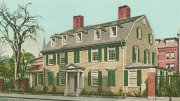In the first half of the 1950s, Henry Beecher of Harvard Medical School oversaw a series of experiments, sponsored by the U.S. Army Research Council, that were designed to test “truth sera” using various drugs, including LSD. The drugs were tested on volunteers, some of them Harvard students. Now Beecher professor of anesthesia James Rathmell is preparing an historical article on Beecher and his research. If you—or anyone you know—volunteered for Beecher’s experiments, Rathmell would like to hear from you: rathmell.james@mgh.harvard.edu. Confidentiality will be assured for those who wish it.
Research Query: LSD Testing in the 1950s
Research Query: LSD Testing in the 1950s
A researcher hopes to contact volunteer participants in “truth sera” experiments.
You might also like
Yesterday’s News
A co-ed experiment that changed dorm life forever
Highlights from Harvard’s Past
The rise of Cambridge cyclists, a lettuce boycott, and Julia Child’s cookbooks
Wadsworth House Nears 300
The building is a microcosm of Harvard’s history—and the history of the United States.
Most popular
Explore More From Current Issue

For Campus Speech, Civility is a Cultural Practice
A former Harvard College dean reviews Princeton President Christopher Eisgruber’s book Terms of Respect.






